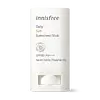What's inside
What's inside
 Key Ingredients
Key Ingredients

 Benefits
Benefits

 Concerns
Concerns

 Ingredients Side-by-side
Ingredients Side-by-side

Isopropyl Palmitate
EmollientButylene Glycol Dicaprylate/Dicaprate
EmollientPolyethylene
AbrasiveC12-15 Alkyl Benzoate
AntimicrobialPolymethylsilsesquioxane
Vinyl Dimethicone/Methicone Silsesquioxane Crosspolymer
Titanium Dioxide
Cosmetic ColorantHdi/Trimethylol Hexyllactone Crosspolymer
Vinyldimethicone
Ozokerite
Emulsion StabilisingAluminum Stearate
Cosmetic ColorantPolyhydroxystearic Acid
EmulsifyingCaprylic/Capric Triglyceride
MaskingPolyglyceryl-4 Diisostearate/Polyhydroxystearate/Sebacate
EmulsifyingAlumina
AbrasiveParfum
MaskingSilica
AbrasiveDehydroacetic Acid
PreservativeStearic Acid
CleansingWater
Skin ConditioningSodium Hyaluronate
Humectant1,2-Hexanediol
Skin ConditioningOpuntia Ficus-Indica Stem Extract
Skin ConditioningIsopropyl Palmitate, Butylene Glycol Dicaprylate/Dicaprate, Polyethylene, C12-15 Alkyl Benzoate, Polymethylsilsesquioxane, Vinyl Dimethicone/Methicone Silsesquioxane Crosspolymer, Titanium Dioxide, Hdi/Trimethylol Hexyllactone Crosspolymer, Vinyldimethicone, Ozokerite, Aluminum Stearate, Polyhydroxystearic Acid, Caprylic/Capric Triglyceride, Polyglyceryl-4 Diisostearate/Polyhydroxystearate/Sebacate, Alumina, Parfum, Silica, Dehydroacetic Acid, Stearic Acid, Water, Sodium Hyaluronate, 1,2-Hexanediol, Opuntia Ficus-Indica Stem Extract
Water
Skin ConditioningPropanediol
SolventOctocrylene
UV AbsorberHomosalate
Skin ConditioningEthylhexyl Salicylate
UV AbsorberButyloctyl Salicylate
Skin ConditioningButyl Methoxydibenzoylmethane
UV AbsorberDiphenylsiloxy Phenyl Trimethicone
Skin ConditioningDimethicone
EmollientVp/Eicosene Copolymer
Silica
AbrasiveTrisiloxane
Skin ConditioningTrimethylsiloxysilicate
Emollient1,2-Hexanediol
Skin ConditioningBehenyl Alcohol
EmollientGlyceryl Stearate
EmollientPEG-100 Stearate
C14-22 Alcohols
Emulsion StabilisingCetyl Alcohol
EmollientPotassium Cetyl Phosphate
EmulsifyingPolyacrylate-13
Polyisobutene
C12-20 Alkyl Glucoside
EmulsifyingButylene Glycol
HumectantDisodium EDTA
Ethylhexylglycerin
Skin ConditioningPolysorbate 20
EmulsifyingSorbitan Isostearate
EmulsifyingDextrin
AbsorbentTheobroma Cacao Extract
Skin ConditioningTocopherol
AntioxidantPanthenol
Skin ConditioningSodium Hyaluronate
Humectant3-O-Ethyl Ascorbic Acid
Skin ConditioningGossypium Herbaceum Extract
Skin ConditioningWater, Propanediol, Octocrylene, Homosalate, Ethylhexyl Salicylate, Butyloctyl Salicylate, Butyl Methoxydibenzoylmethane, Diphenylsiloxy Phenyl Trimethicone, Dimethicone, Vp/Eicosene Copolymer, Silica, Trisiloxane, Trimethylsiloxysilicate, 1,2-Hexanediol, Behenyl Alcohol, Glyceryl Stearate, PEG-100 Stearate, C14-22 Alcohols, Cetyl Alcohol, Potassium Cetyl Phosphate, Polyacrylate-13, Polyisobutene, C12-20 Alkyl Glucoside, Butylene Glycol, Disodium EDTA, Ethylhexylglycerin, Polysorbate 20, Sorbitan Isostearate, Dextrin, Theobroma Cacao Extract, Tocopherol, Panthenol, Sodium Hyaluronate, 3-O-Ethyl Ascorbic Acid, Gossypium Herbaceum Extract
 Reviews
Reviews

Ingredients Explained
These ingredients are found in both products.
Ingredients higher up in an ingredient list are typically present in a larger amount.
1,2-Hexanediol is a synthetic liquid and another multi-functional powerhouse.
It is a:
- Humectant, drawing moisture into the skin
- Emollient, helping to soften skin
- Solvent, dispersing and stabilizing formulas
- Preservative booster, enhancing the antimicrobial activity of other preservatives
Silica, also known as silicon dioxide, is a naturally occurring mineral. It is used as a fine, spherical, and porous powder in cosmetics.
Though it has exfoliant properties, the function of silica varies depending on the product.
The unique structure of silica enhances the spreadability and adds smoothness, making it a great texture enhancer.
It is also used as an active carrier, emulsifier, and mattifier due to its ability to absorb excess oil.
In some products, tiny microneedles called spicules are made from silica or hydrolyzed sponge. When you rub them in, they lightly polish away dead skin layers and enhance the penetration of active ingredients.
Learn more about SilicaSodium Hyaluronate is hyaluronic acid's salt form. It is commonly derived from the sodium salt of hyaluronic acid.
Like hyaluronic acid, it is great at holding water and acts as a humectant. This makes it a great skin hydrating ingredient.
Sodium Hyaluronate is naturally occurring in our bodies and is mostly found in eye fluid and joints.
These are some other common types of Hyaluronic Acid:
Learn more about Sodium HyaluronateWater. It's the most common cosmetic ingredient of all. You'll usually see it at the top of ingredient lists, meaning that it makes up the largest part of the product.
So why is it so popular? Water most often acts as a solvent - this means that it helps dissolve other ingredients into the formulation.
You'll also recognize water as that liquid we all need to stay alive. If you see this, drink a glass of water. Stay hydrated!
Learn more about Water